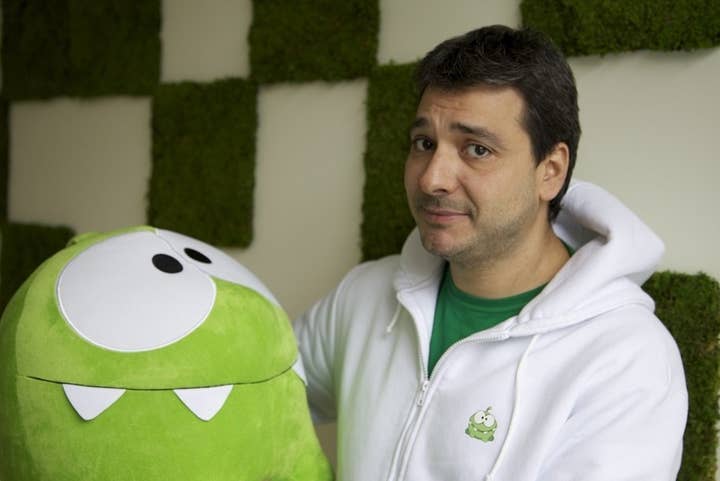"I think hardcore is a lot easier" -ZeptoLab CEO
Misha Lyalin explains the challenge of midcore development as his studio expands beyond the Cut the Rope franchise with King of Thieves
ZeptoLab is ready to cut down on its Cut the Rope dependence. Ever since the Russian developer released the first title in the hit franchise about four years ago, it has largely focused on Cut the Rope sequels and spin-offs. That might change this year, as the studio is preparing to roll out a number of new intellectual properties over the course of 2015.
This isn't the first time ZeptoLab has attempted to branch out beyond its flagship franchise and omnivorous mascot Om Nom Nom. Several years ago the company released the puzzle-action game Pudding Monsters, but as ZeptoLab CEO Misha Lyalin told GamesIndustry.biz, it was selling for the wrong price ($1) at the wrong time.
"When Pudding Monsters was coming out, we already understood it was probably not going to do very well because the paid market was exhibiting signs of losing out to free-to-play at the time," Lyalin said. "What we understood was that if we want to develop something that will be current in the market, we need to look at the trends, predict the state of technology and networks, and then try to ship the product that will make sense at that time. The number one lesson was to build for the market that will be there when the game's released, not the one that's there when we first conceive it."
"The number one lesson was to build for the market that will be there when the game's released, not the one that's there when we first conceive it."
Next month will see ZeptoLab release the first of its new IP slate, King of Thieves, which Lyalin said was designed from the ground up as a free-to-play massively multiplayer game. But following on from the company's big takeaway with Pudding Monsters, King of Thieves was built over the last two years with an eye for what the market would want right now. That's the longest development period of any ZeptoLab game to date, and Lyalin said under ordinary circumstances, the plug would have been pulled long ago.
"We wanted to kill it so many times, but we just liked every iteration we came up with," Lyalin said. "That's why it took us so long. And we're glad it did, because now we're ready to ship this product to people."
Lyalin said in the end, the amount of time it took to develop the game is irrelevant if he winds up shipping the right product at the right time for the market. And for the mobile market right now, Lyalin thinks that means a midcore game.
"Long term retention is more important than a short-term experience, right? So even though the setting is casual, the game gets more hardcore when you get to 120 days or year two or whatever in the game," Lyalin said. "This is what midcore is. You get more people interested, and more people are playing the game initially, but the experience becomes a little more hardcore. Those [casual] people vaporize and more hardcore people stay."
For King of Thieves, ZeptoLab is working to make it accessible from the start. It capitalizes on the studio's design strengths, with a cartoonish visual style somewhat similar to the Cut the Rope franchise. It's also simple from a gameplay perspective at first, a new take on the endless runner genre. However, Lyalin says the experience gets more intense as players stick with the game; it opens up to player-vs-player competition, forming guilds, and other such staples of more hardcore games. And while a midcore approach might work well for bringing in loads of people and keeping them engaged, Lyalin said it's a trickier challenge, design-wise.
"The potential of midcore games is probably larger in general than true hardcore games. There might be a sweet spot, but it's a more difficult sweet spot to hit.."
"To be honest, I think hardcore is a lot easier," Lyalin said. "If you have a mechanic you found that works for people that are accustomed to paying for games, it's just easier. If you're a hardcore player, you know pretty soon if you're going or not. It's a behavior we can predict. With midcore, it's a lot more challenging because you're catching a lot of casual people and you don't know how they're going to act, and what's going to happen to them. What I would say is the potential of midcore games is probably larger in general than true hardcore games. There might be a sweet spot, but it's a more difficult sweet spot to hit."
ZeptoLab managed to produce exactly the right product at the right time once before with Cut the Rope. And while its ensuing success drew plenty of attention, the studio remained independent even as many of its fellow chart-topping outfits were accepting acquisition bids for sometimes ludicrous amounts of money. ZeptoLab didn't sell at the time, and it's a decision Lyalin has no second thoughts about.
"I think the biggest deals are yet to come, to be honest," Lyalin said. "Not that we're waiting for the biggest deal; we'll very happily stay independent at this point. But it's just the beginning."
People are spending more time playing games on their phones, Lyalin noted. He added the global installed base of smartphones is only increasing, and pointed to huge opportunities in emerging markets.
"I think there are several things that have happened here and we just want to do more before we have conversations with people. Nobody has to sell out in order to make money. Gaming is a great industry that provides a lot of cash flow. It's a great business, so why sell out?"

